Why the Maijishan Grottoes Should Be on Your Travel Bucket List
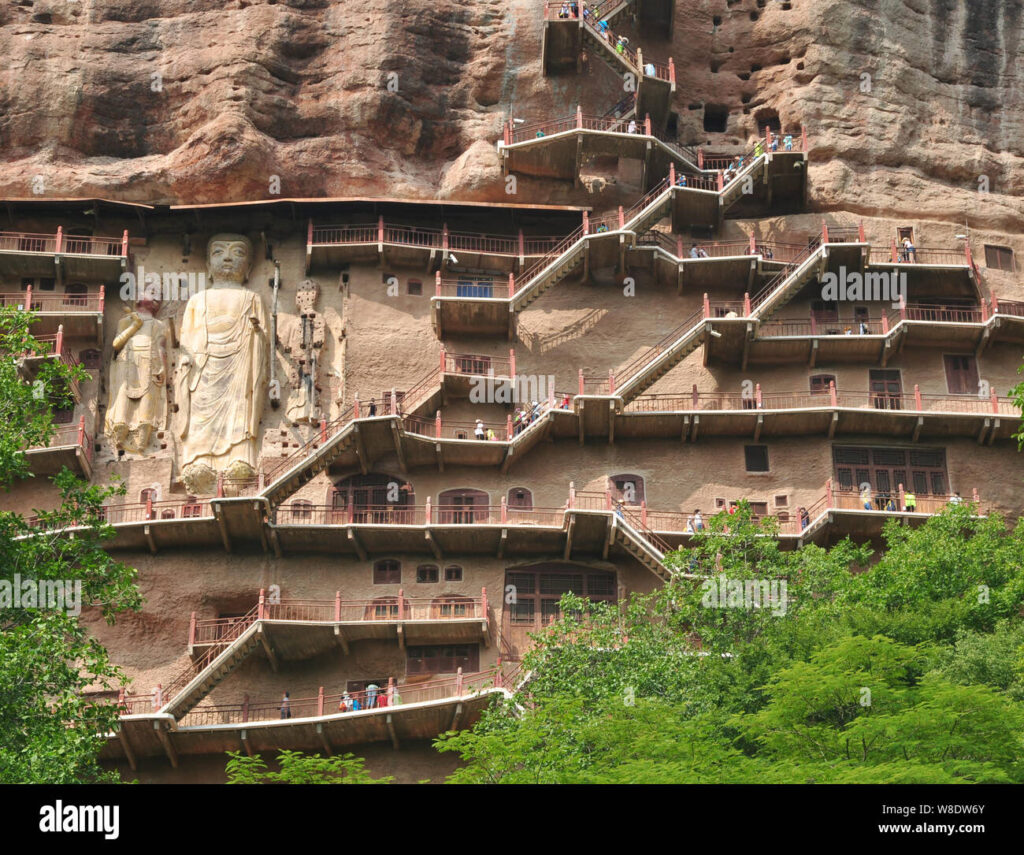
An Essential Guide to Visiting Maijishan Grottoes
Nestled in the enchanting landscapes of Tianshui, Gansu Province, the Maijishan Grottoes are a breathtaking testament to the intersection of art, history, and spirituality. This remarkable site, often referred to as the “Oriental Sculpture Museum,” boasts nearly 194 grottoes carved into the towering cliffs, showcasing an astonishing collection of over 7,200 clay Buddha statues. As you embark on your journey, prepare to traverse steep pathways and winding staircases that lead you through centuries of Buddhist artistry, offering glimpses into the rich cultural tapestry of the Silk Road.
The experience of visiting the Maijishan Grottoes is as much about the physical ascent as it is about the spiritual elevation. The climb, though demanding, rewards you with not only the stunning views of the surrounding mountains but also the opportunity to witness the vivid remnants of ancient pigments that still cling to many of the sculptures. Each grotto holds its own story, echoing the devotion of the artisans who dedicated their lives to creating these masterpieces.
Whether you’re an avid history buff, a lover of art, or simply seeking a unique adventure, Maijishan is a destination that promises unforgettable moments. From the local souvenir stalls that line the path to the serene atmosphere that envelops the site, every step taken in this ancient sanctuary is a step back in time. Get ready to immerse yourself in the rich heritage of one of China’s most treasured cultural landmarks!
In This Guide
- An Essential Guide to Visiting Maijishan Grottoes
- The Rich History and Legends of Maijishan Grottoes
- Main Highlights: What You Absolutely Can’t Miss
- Planning Your Visit: A Practical Guide
- Tickets: Prices, Booking, and Tips
- How to Get There: A Complete Transportation Guide
- Local Cuisine and Accommodation Nearby
- Frequently Asked Questions
- Final Thoughts on Your Trip
The Rich History and Legends of Maijishan Grottoes
Nestled in the heart of Gansu Province, the Maijishan Grottoes, known as 麦积山石窟, stand as a testament to centuries of artistic and spiritual devotion. This remarkable site, often referred to as the “Oriental Sculpture Museum,” is not just a collection of caves; it is a rich tapestry woven from the threads of history, culture, and legend.
The history of the Maijishan Grottoes dates back to the late Northern Wei Dynasty, around the 4th century, when Buddhist monks began carving these sacred spaces into the soft sandstone cliffs. The site flourished during the Tang Dynasty (618-907 AD), a golden age for Buddhism in China, when artistry and craft reached new heights. It is during this period that many of the 194 grottoes, containing approximately 7,200 statues, were intricately designed and adorned with vibrant pigments, some of which still cling to the statues today, offering a glimpse into the past.
Strategically located along the ancient Silk Road, Maijishan served as a crucial stop for traders and pilgrims alike. This convergence of commerce and spirituality allowed the grottoes to thrive, bringing together diverse influences that shaped their artistic style. Many of the sculptures depict the compassionate figure of Avalokiteshvara, the bodhisattva of mercy, alongside various other Buddhist deities, reflecting the syncretism that flourished during this era.
As travelers ascend the steep pathways that connect the grottoes, they embark on a journey not just through space, but through time. The series of walkways clings to the cliffside, leading visitors through a labyrinth of history. The climb, while demanding, rewards the persistent with breathtaking views and an intimate encounter with the divine artistry housed within each cave. The higher one climbs, the more impressive the sculptures become, showcasing the incredible craftsmanship of the eras they represent.
Legends abound in the lore of Maijishan. One tale suggests that the mountain was formed from the grains of wheat scattered by the hands of ancient deities, which gives the formation its distinct resemblance to a wheat sheaf. Another legend speaks of the great monk Xuanzang, who journeyed to India to retrieve sacred texts and is said to have visited the grottoes during his travels, further enhancing their reputation as a center of learning and spirituality.
Today, Maijishan Grottoes are recognized as a UNESCO World Heritage Site and remain one of the most significant collections of Buddhist art in China. They draw thousands of visitors each year, eager to witness the magnificent blend of natural beauty and human creativity. The ongoing preservation efforts ensure that future generations will continue to marvel at the intricate clay statues and the rich history that they embody.
For those seeking a deep connection with the past, a visit to the Maijishan Grottoes is not merely a sightseeing venture; it is an immersion into a world where art, faith, and history converge, leaving an indelible mark on the soul of every traveler.
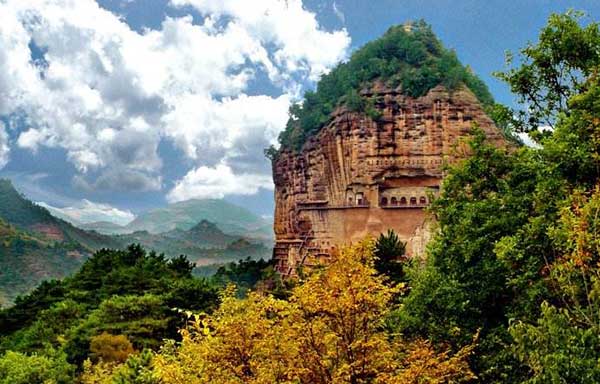
Maijishan Grottoes.
Main Highlights: What You Absolutely Can’t Miss
The Maijishan Grottoes, often referred to as the “Oriental Sculpture Museum,” is an extraordinary site that offers an insight into the rich tapestry of Buddhist art and history. Nestled in the picturesque Maiji Mountain Scenic Area, this UNESCO World Heritage site is a must-visit for any traveler intrigued by culture, art, and history. Here’s what you absolutely cannot miss:
1. Breathtaking Grottoes and Sculptures
With nearly 194 grottoes housing around 7,200 clay sculptures, the Maijishan Grottoes are a treasure trove of Buddhist artistry. The intricate carvings and vibrant remnants of original pigments on many of the statues provide a glimpse into the artistic prowess of the craftsmen from centuries past. Each grotto is unique and tells its own story, showcasing various styles influenced by the Silk Road.
2. Stunning Cliffside Walkways
As you ascend the site, you’ll traverse a series of constructed walkways that cling to the cliffs, offering not only a close-up view of the sculptures but also breathtaking views of the surrounding landscape. Be prepared for a workout; the climb involves approximately 34 flights of catwalks and steep stairways. However, the panoramic vistas and the thrill of standing among ancient art make every step worthwhile.
3. Historical Significance
The Maijishan Grottoes date back to the 4th century and were developed over several dynasties. This historical significance adds a layer of depth to your visit. Your local guides can provide valuable insights into the cultural and historical context of the grottoes, making the experience educational as well as visually stunning.
4. Preservation Efforts
Some sculptures are protected behind mesh screens to preserve their integrity. While this may limit your ability to capture perfect photographs, it highlights the importance of conservation efforts in protecting these irreplaceable artworks for future generations.
5. Local Culture and Souvenirs
At the foot of Maijishan, you’ll find local souvenir stalls offering unique handicrafts. Take the time to explore these stalls to find a special memento of your visit, whether it’s traditional art, textiles, or local snacks. Engaging with local vendors can also provide you with a richer understanding of the culture.
6. Guided Tours and Experiences
Consider joining one of the guided tours available. These tours often include transportation, making your visit more convenient and enriching. Guides typically share fascinating stories and facts that you might not discover on your own, enhancing your overall experience.
7. Nearby Attractions
While the Maijishan Grottoes are the highlight, don’t miss the opportunity to explore nearby attractions such as the Tianshui Museum and the Xiaolong Mountain National Nature Reserve. These sites complement your experience and deepen your appreciation of the region’s natural beauty and cultural heritage.
Final Thoughts
Visiting the Maijishan Grottoes is not just a sightseeing trip; it’s an immersion into the heart of Buddhist art and culture. With every step through the grottoes, you’ll feel the echoes of history and the artistry of ancient craftsmen. Whether you’re an art enthusiast, a history buff, or simply a curious traveler, this destination promises to leave you in awe.
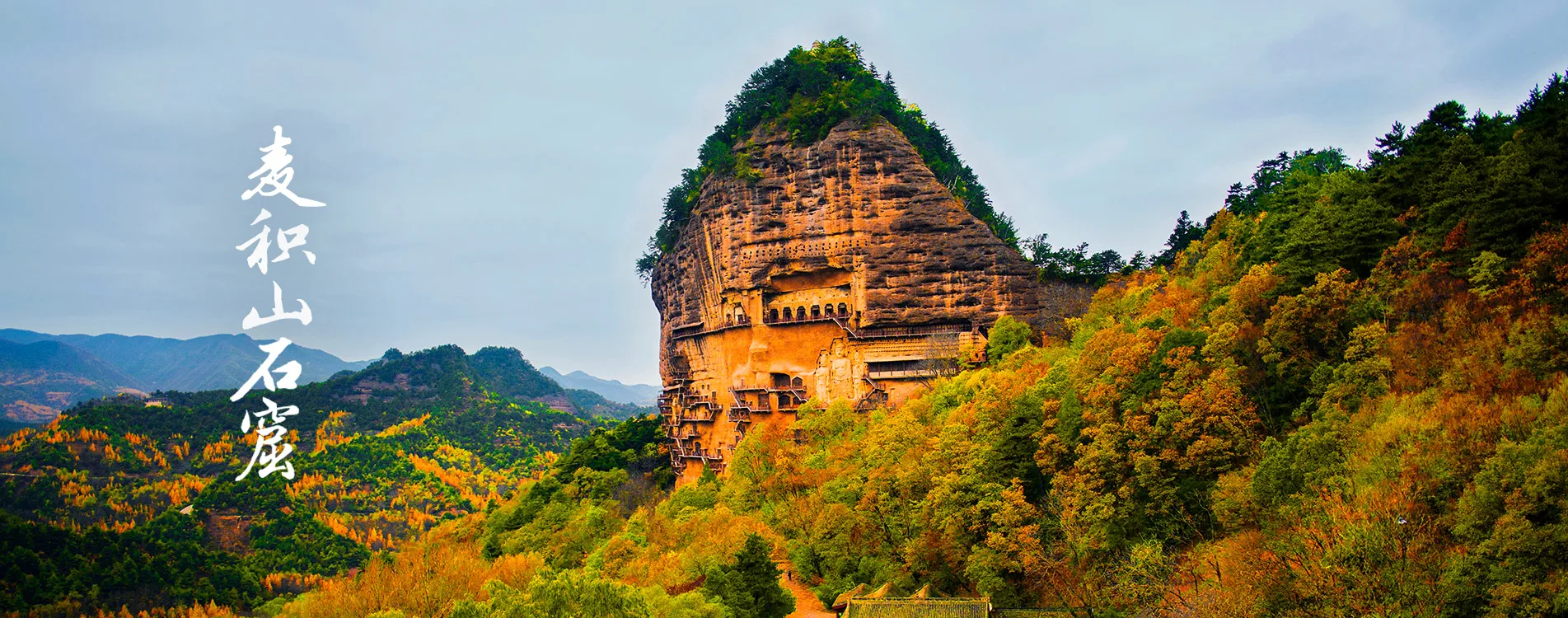
Maijishan Grottoes.
Planning Your Visit: A Practical Guide
Visiting the Maijishan Grottoes is an unforgettable experience for any traveler interested in history, art, and culture. Nestled in the scenic Maiji District of Tianshui, Gansu Province, these magnificent Buddhist caves offer a glimpse into the artistry and spirituality of ancient China. Here’s everything you need to know to plan your visit.
Getting There
By Air: The nearest airport is Tianshui Maijishan Airport (THQ), which connects to major cities in China. From the airport, you can take a taxi or pre-arranged transfer to the grottoes.
By Train: Tianshui has a railway station with services from major cities, including Lanzhou and Xi’an. Once you arrive in Tianshui, local buses and taxis are available to take you to the grottoes.
By Bus: You can also reach Tianshui via long-distance buses from various locations. The city is well-connected and offers frequent services.
Entrance to Maijishan Grottoes
Upon arrival, a shuttle bus will take you from the parking area to the entrance of the grottoes. Keep in mind that there is a considerable distance to walk from the bus stop to the entrance, which is often lined with local souvenir stalls.
What to Expect
Once you enter the grotto complex, prepare for a rewarding but physically demanding experience. The site consists of approximately 194 grottoes connected by a series of catwalks and steep stairways that ascend the cliffside. In total, you will navigate around 34 flights of stairs, giving you a chance to immerse yourself in the impressive art and architecture.
Sculptures and Art: The Maijishan Grottoes are renowned for their stunning clay sculptures, with almost 7,200 statues on display, many of which have retained their original pigments. Some sculptures are housed behind protective mesh, so be ready to capture the best possible photographs in the available light.
Best Time to Visit
The best time to visit the Maijishan Grottoes is during the spring (April to June) and autumn (September to November) months when the weather is mild and pleasant. Summers can be hot, while winters may bring chilly temperatures.
What to Bring
- Comfortable Shoes: Given the extensive walking and climbing involved, sturdy, comfortable footwear is essential.
- Water and Snacks: Staying hydrated is important, especially during the climb. There are also small shops along the way where you can purchase refreshments.
- Camera: Capture the breathtaking views and intricate sculptures, but be mindful of any restrictions on photography in certain areas.
- Sunscreen and Hat: Protect yourself from the sun, particularly during the warmer months.
Nearby Attractions
If time permits, consider exploring other attractions in Tianshui, such as the Fuxi Temple, Tianshui Museum, and Xiaolong Mountain National Nature Reserve. Each offers unique insights into the cultural and natural heritage of the region.
Guided Tours
For a more enriching experience, consider joining a guided tour. Many local operators offer half-day or full-day tours that include transportation, a knowledgeable guide, and sometimes lunch. This can enhance your understanding of the grottoes’ historical significance and the intricacies of the art.
Conclusion
A visit to the Maijishan Grottoes is more than just an exploration of ancient art; it’s a journey through time that connects you with the spiritual and cultural history of Buddhism along the Silk Road. Prepare for an adventure that combines physical exertion with the awe of exquisite craftsmanship, making your trip to Tianshui truly memorable.
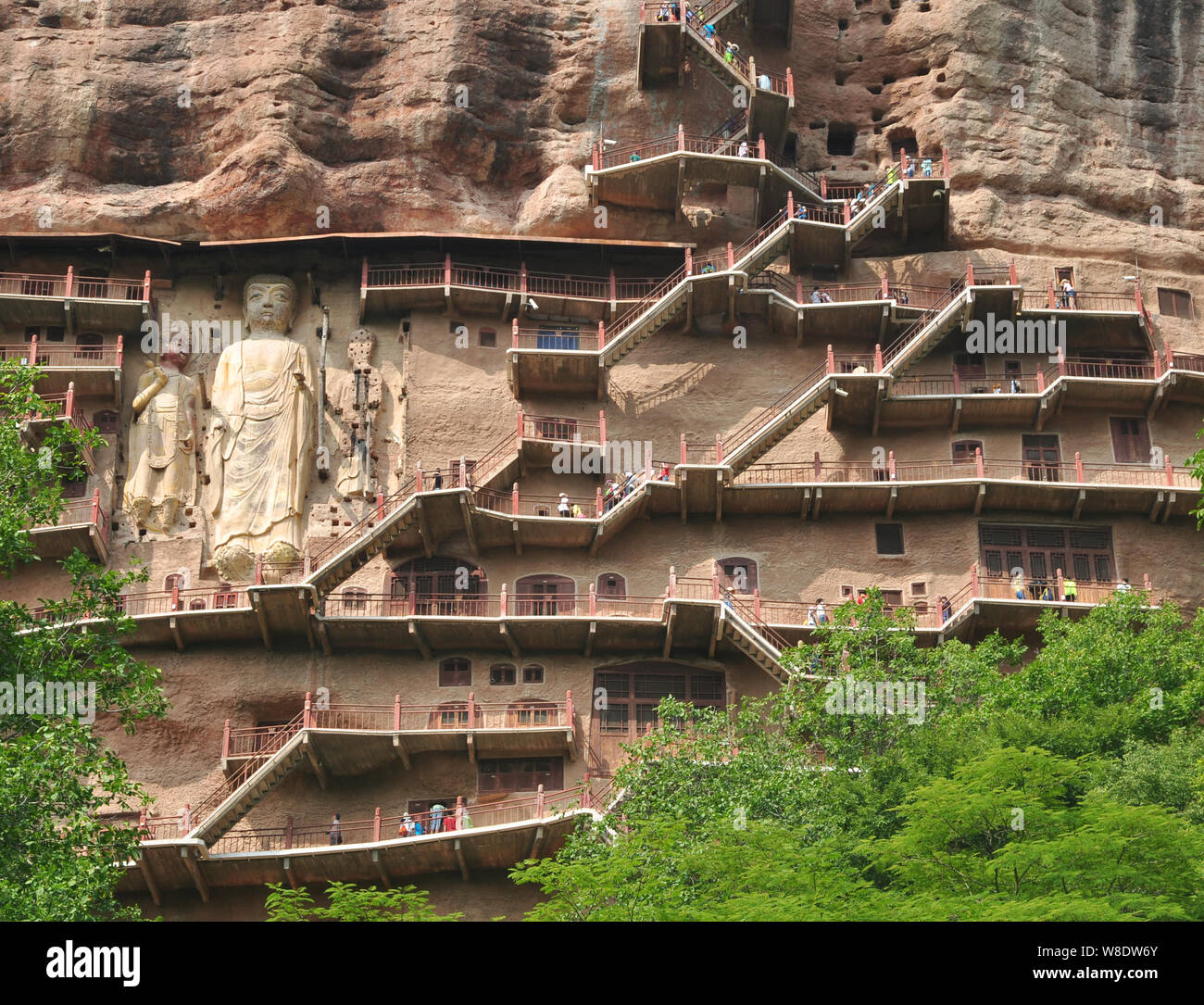
Maijishan Grottoes.
Tickets: Prices, Booking, and Tips
Visiting the Maijishan Grottoes is a captivating journey through history and art, but knowing the ticket options and tips for a smooth experience can enhance your adventure. Here’s what you need to know before you go.
Ticket Prices
As of 2025, the general admission ticket for the Maijishan Grottoes is approximately RMB 80 (around $12). This ticket grants you access to the grottoes and the surrounding scenic area, allowing you to explore nearly 194 grottoes and marvel at around 7,200 clay Buddha statues that date back to the Northern Wei period.
Booking Options
Tickets can typically be purchased at the entrance, but to avoid long lines, consider booking in advance through travel agencies or online platforms that specialize in Chinese attractions. It’s advisable to check for any discounts or package deals that may include guided tours or additional services, which can enhance your visit.
Guided Tours
For an in-depth experience, you might want to consider joining a guided tour. Private tours to the Maijishan Grottoes start at around $174 for a half-day tour, and can go up to $769 for comprehensive four-day trips that include various local attractions. These tours often include transportation, lunch, and the expertise of a local guide, providing valuable context to the impressive artworks you’ll encounter.
Getting There
Access to the grottoes typically involves a shuttle bus that transports visitors from designated points to the entrance. Be prepared for a bit of a hike once you arrive; the paths leading up to the grottoes require climbing steep stairways and catwalks, totaling around 34 flights. Comfortable shoes and plenty of water are essential for this journey.
Tips for Your Visit
- Timing: Aim to visit early in the day or later in the afternoon to avoid crowds and enjoy a more peaceful experience.
- Photography: Some areas may be dimly lit and have protective barriers, so be mindful of your camera settings to capture the best photos of these ancient works of art.
- Local Souvenirs: As you make your way to the grottoes, you’ll pass by various stalls selling local crafts and souvenirs. It’s a great opportunity to pick up unique items to remember your trip.
With this information in hand, you’re well-equipped to explore the stunning Maijishan Grottoes. Enjoy your adventure through this remarkable historical site!
How to Get There: A Complete Transportation Guide
To embark on a journey to the mesmerizing Maijishan Grottoes, nestled in the picturesque Maiji District of Tianshui, China, you’ll find a variety of transportation options that cater to international travelers. This guide will help you navigate your way to this UNESCO World Heritage site, known for its stunning collection of clay Buddha sculptures and rich history along the Silk Road.
Getting to Tianshui
By Air:
The closest airport to the Maijishan Grottoes is Tianshui Maijishan Airport (THQ), located approximately 30 kilometers from the grottoes. While it has limited domestic flights, you can easily connect from major Chinese cities like Beijing, Shanghai, or Xi’an. From the airport, travelers can opt for a taxi or arrange for a private transfer to reach the grottoes.
By Train:
Tianshui Railway Station is well-connected to several major cities in China, making it a convenient option for travelers. High-speed trains run frequently from Xi’an (around 2 hours), Lanzhou (approximately 2.5 hours), and other regional hubs. Once you arrive at Tianshui Railway Station, you can take a taxi or local bus to reach the grottoes, which are about 15 kilometers away.
By Bus:
For those traveling on a budget, long-distance buses are available from various cities. Tianshui has several bus terminals, with connections from major cities such as Lanzhou, Xi’an, and Chengdu. Once in Tianshui, you can easily find local buses or taxis that will take you to the Maijishan Scenic Area.
Local Transportation Options
Once you arrive in Tianshui, reaching the Maijishan Grottoes is straightforward:
Shuttle Bus:
A shuttle bus service operates from Tianshui city center directly to the Maijishan Scenic Area. It’s a convenient option, especially for visitors who wish to avoid the hassle of navigating local transportation. The bus ride takes about 30 minutes, and tickets can be purchased at local travel agencies or designated bus stations.
Taxi Services:
Taxis are readily available in Tianshui and provide a direct and comfortable way to reach the grottoes. Be sure to have your destination written in Chinese to show the driver, as English may not be widely spoken. A taxi ride from the city center to the grottoes typically takes around 30 minutes.
Exploring the Grottoes
Upon arriving at the Maijishan Scenic Area, visitors will need to navigate a series of walkways and staircases to reach the grottoes themselves. A shuttle bus takes you to the entrance, but be prepared for a scenic yet tiring climb of approximately 34 flights of catwalks and steep stairways to fully appreciate the nearly 7200 statues and the breathtaking views that accompany them.
Tips for Your Visit
- Plan Ahead: Given its popularity, consider visiting early in the day to avoid crowds and enjoy the site at a leisurely pace.
- Wear Comfortable Shoes: The climb can be steep and involves a lot of walking, so comfortable footwear is essential.
- Stay Hydrated: Bring water with you, especially during warmer months, as the climb can be strenuous.
By utilizing these transportation options and tips, your visit to the Maijishan Grottoes will be an unforgettable adventure, allowing you to soak in the beauty of this ancient treasure. Enjoy your journey!
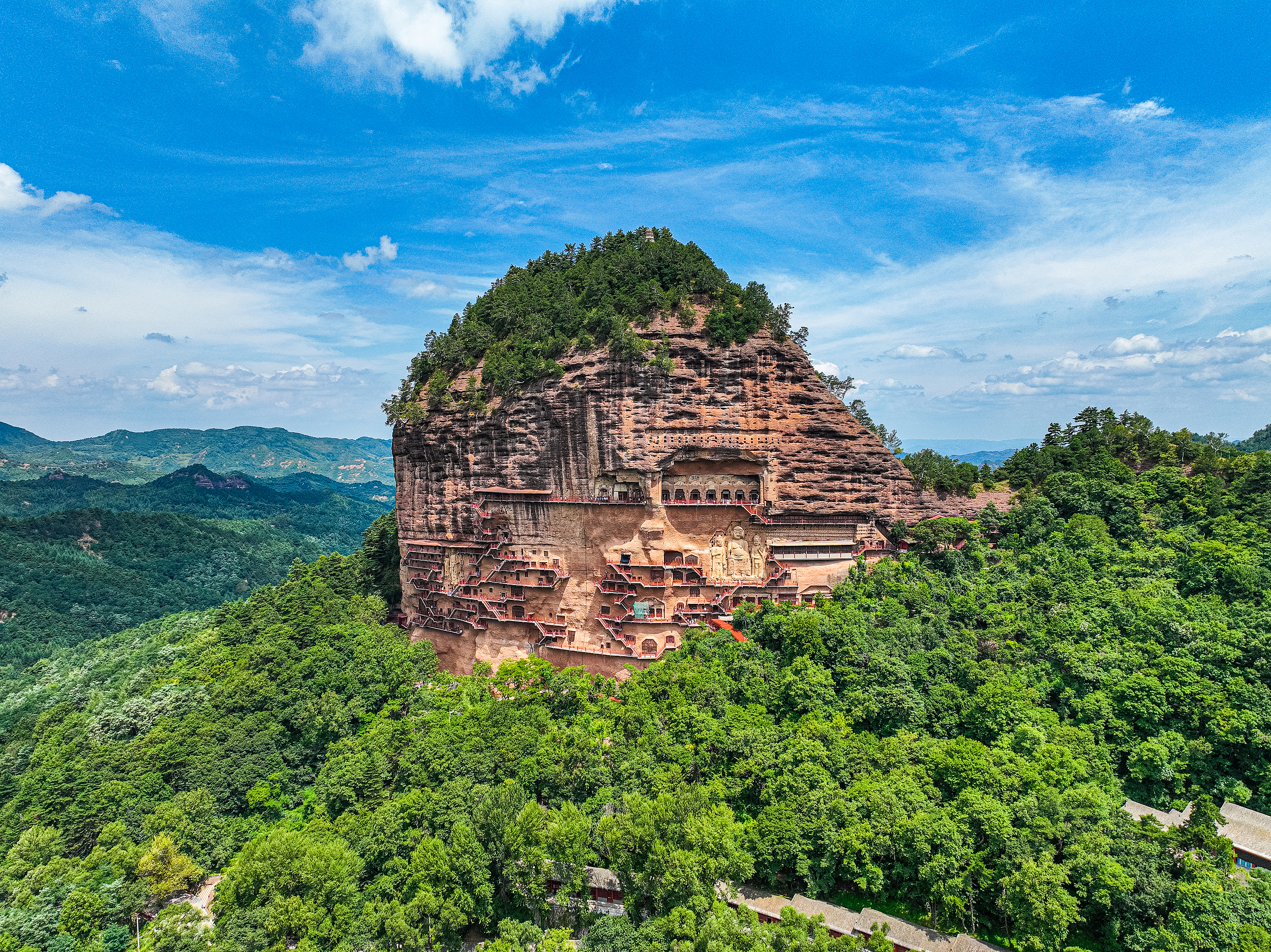
Maijishan Grottoes.
Local Cuisine and Accommodation Nearby
When visiting the breathtaking Maijishan Grottoes, not only can you immerse yourself in a remarkable collection of ancient Buddhist art, but you can also indulge in the local flavors and find cozy accommodations to enhance your trip experience.
Local Cuisine
After a long day of exploring the 194 grottoes and marveling at nearly 7,200 clay Buddha sculptures, treating yourself to a delicious meal is a must. Here are some local dining spots you shouldn’t miss:
-
Tianshui Noodle House: A favorite among tourists and locals alike, this eatery specializes in hand-pulled noodles, a staple in the region. Pair your noodles with a rich broth and fresh vegetables for a hearty meal.
-
Maiji Mountain Restaurant: Located conveniently near the entrance of the grottoes, this restaurant offers traditional Gansu cuisine. Try the local lamb dishes, which are prepared with spices that bring out the rich flavors of the meat.
-
Dumpling Corner: Known for its delightful dumplings, this spot is perfect for a quick bite. Enjoy a variety of fillings, from pork and chives to vegetarian options, all steamed to perfection.
-
Yuanxin Tea House: After a meal, relax at this charming tea house where you can savor local teas and some traditional snacks. The atmosphere is serene, making it a perfect spot to unwind after your adventures.
Accommodation Nearby
For a restful night’s sleep after your exploration of the Maijishan Grottoes, consider these recommended accommodations:
-
Tianshui Grand Hotel: A luxurious option with modern amenities, this hotel is just a short drive from the grottoes. It offers spacious rooms, a fitness center, and an on-site restaurant that serves both local and international cuisine.
-
Jinjiang Inn Tianshui: This budget-friendly hotel provides comfortable and clean accommodations. It’s conveniently located near public transportation, making it easy to visit the grottoes and other attractions in Tianshui.
-
Home Inn Tianshui Railway Station: Ideal for those traveling by train, this hotel offers simple yet cozy rooms. The staff is friendly, and they provide helpful information about local attractions and dining options.
-
Maijishan Scenic Area Inn: For those seeking a more rustic experience, this inn is nestled in nature, providing stunning views of the surrounding landscape. It’s a peaceful retreat that allows you to connect with the natural beauty of the area.
Whether you’re savoring the local delicacies or settling in for the night, the area surrounding the Maijishan Grottoes offers a delightful blend of culture, comfort, and culinary experiences to enrich your visit.
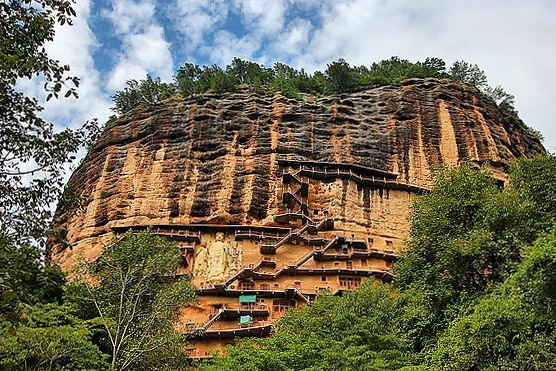
Maijishan Grottoes.
Frequently Asked Questions
Frequently Asked Questions About Maijishan Grottoes
-
What are the Maijishan Grottoes?
The Maijishan Grottoes, located in Tianshui, Gansu Province, China, are a stunning collection of Buddhist sculptures and rock carvings that date back to the 4th century. The site features approximately 194 grottoes, housing around 7,200 clay statues and intricate murals, making it one of the most significant treasures of Buddhist art along the ancient Silk Road. -
How do I get to the Maijishan Grottoes?
The grottoes are accessible by public transportation or taxi from Tianshui city center. A shuttle bus service is available that takes visitors from the parking area to the entrance of the site. Be prepared for a bit of a walk to reach the grottoes after the shuttle drops you off. -
What should I wear when visiting?
Comfortable walking shoes are essential, as you will be climbing approximately 34 flights of stairs and navigating steep walkways to explore the grottoes. Lightweight clothing is recommended, especially during warmer months, and don’t forget to bring a hat and sunscreen for sun protection. -
Are there guided tours available?
Yes, guided tours are available and highly recommended for a richer experience. Local guides can provide valuable insights into the history and significance of the sculptures. You can book private or group tours in advance or find options upon arrival at the site. -
Is there an entrance fee?
Yes, there is an entrance fee to visit the Maijishan Grottoes. The fee may vary, so it’s advisable to check the latest prices before your visit. Some tours might include the entrance fee in their packages. -
What facilities are available at the site?
The site offers basic facilities, including restrooms and snack stalls. Visitors can also find souvenir shops along the pathway to the grottoes. However, it’s a good idea to bring water and snacks, especially if you plan to spend several hours exploring. -
Can I take photographs inside the grottoes?
Photography rules can vary within the grottoes. While you can often take photos of the exterior and some open areas, certain grottoes may have restrictions to protect the delicate artwork. It’s best to respect the guidelines posted at each site. -
What is the best time to visit Maijishan Grottoes?
The ideal time to visit is during spring (April to June) and autumn (September to November) when the weather is mild and pleasant for hiking. Summer can be hot, while winter may bring cold temperatures and snow. Checking the weather forecast before your visit can help you plan accordingly.
Final Thoughts on Your Trip
As your journey to the Maijishan Grottoes comes to a close, take a moment to reflect on the incredible experience you’ve had. Nestled in the stunning landscapes of Gansu province, these grottoes stand as a testament to the artistry and devotion of centuries past. The tireless climb through the winding pathways, adorned with intricate clay Buddha sculptures, offers not just a physical challenge but also a spiritual reward—each step bringing you closer to the profound beauty and history that these caves encapsulate.
The vivid colors that still cling to the ancient statues, the stories whispered by the winds through the cliffs, and the breathtaking views from the heights all contribute to an experience that transcends mere sightseeing. It’s a place where history and nature intertwine, inviting you to connect with the rich tapestry of culture along the Silk Road.
As you leave, carry with you the serenity and inspiration drawn from this remarkable site. Whether you’re sharing tales of your adventure with friends or simply cherishing the memories for yourself, the Maijishan Grottoes will undoubtedly leave an indelible mark on your heart. Safe travels as you continue to explore the wonders of the world!